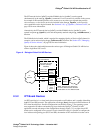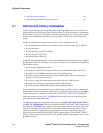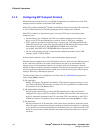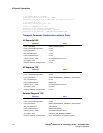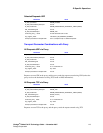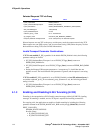108 Dialogic
®
Global Call IP Technology Guide — November 2007
Dialogic Corporation
IP-Specific Operations
• LAN Disconnection Alarms . . . . . . . . . . . . . . . . . . . . . . . . . . . . . . . . . . . . . . . . . . . . . 333
• Setting Dialogic® IP Media Library Parameters . . . . . . . . . . . . . . . . . . . . . . . . . . . . . 335
4.1 Call Control Library Initialization
Certain system parameters are configurable when using the gc_Start( ) function to initialize the
Dialogic
®
Global Call API library. Some of these parameters, such as the number of virtual boards
and the choice of first party or third party call control operating mode, are set for the entire system,
but most of the configuration parameters are set separately for each of the virtual boards in the
system.
Among the configuration items that can be set for on a per-virtual board basis are:
• the maximum number of IPT devices available on the virtual board (total, H.323, and SIP)
• the local IP address
• the call signaling ports (H.323 and SIP)
• the terminal type (H.323 only)
• the outbound proxy (SIP only)
In addition, the configuration process is also used to enable certain features that have been added to
the Dialogic
®
Global Call API library as it has evolved in order to ensure backwards compatibility.
These features include:
• the call transfer supplementary service
• the ability to access H.323 message information fields and/or SIP message header fields
• the ability to access MIME-encoded message bodies in SIP messages
• the ability to access tunneled signaling messages (TSMs) and/or user-to-user information
elements (UU-IEs) in H.323 messages
• the ability to control the transport protocol and retry behavior for SIP messages
• the ability to use Transport Layer Security (TLS) for SIP messages
• the ability to handle SIP OPTIONS requests under application control
System configuration is accomplished using two different data structures, which are initialized to
default values and then customized to suit the specific configuration before calling the gc_Start( )
function. System-level configuration items are set in a IPCCLIB_START_DATA data structure,
which also references an array of IP_VIRTBOARD data structures (one per virtual board) that
specify board-level configuration items.
The application begins the configuration process by using the INIT_IPCCLIB_START_DATA( )
and INIT_IP_VIRTBOARD( ) functions to initialize the IPCCLIB_START_DATA structure and
each of the IP_VIRTBOARD data structures. These initialization functions set default values that
can then be overridden with desired values. After setting whatever non-default values it desires
(there is no need for the application to set any item that it is leaving at the default value), the
application references the IPCCLIB_START_DATA structure from a CCLIB_START_STRUCT
structure, which in turn is referenced from the GC_START_STRUCT structure that is passed to the
gc_Start( ) function.






